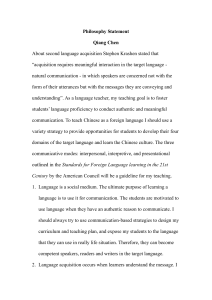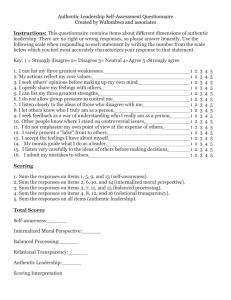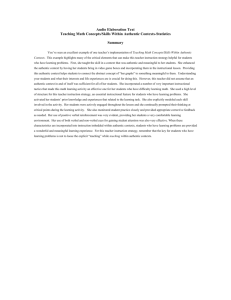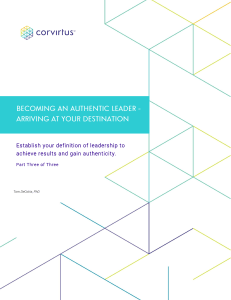THE IMPACT OF AUTHENTIC LEADERSHIP ON JOB
advertisement
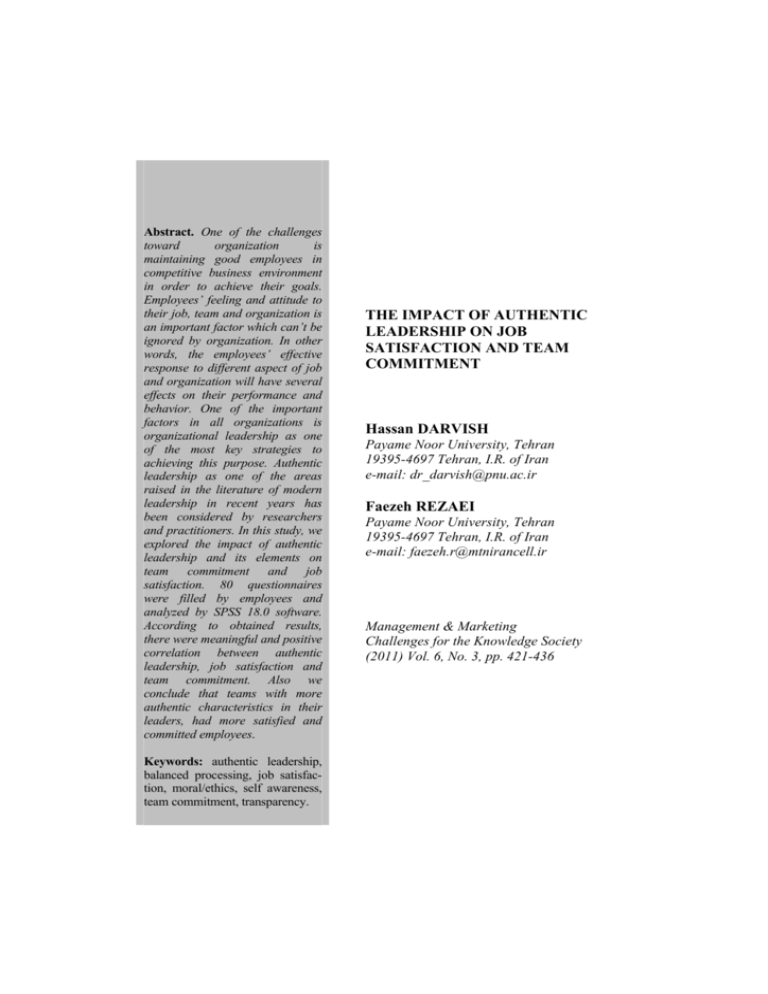
Abstract. One of the challenges toward organization is maintaining good employees in competitive business environment in order to achieve their goals. Employees’ feeling and attitude to their job, team and organization is an important factor which can’t be ignored by organization. In other words, the employees’ effective response to different aspect of job and organization will have several effects on their performance and behavior. One of the important factors in all organizations is organizational leadership as one of the most key strategies to achieving this purpose. Authentic leadership as one of the areas raised in the literature of modern leadership in recent years has been considered by researchers and practitioners. In this study, we explored the impact of authentic leadership and its elements on team commitment and job satisfaction. 80 questionnaires were filled by employees and analyzed by SPSS 18.0 software. According to obtained results, there were meaningful and positive correlation between authentic leadership, job satisfaction and team commitment. Also we conclude that teams with more authentic characteristics in their leaders, had more satisfied and committed employees. Keywords: authentic leadership, balanced processing, job satisfaction, moral/ethics, self awareness, team commitment, transparency. THE IMPACT OF AUTHENTIC LEADERSHIP ON JOB SATISFACTION AND TEAM COMMITMENT Hassan DARVISH Payame Noor University, Tehran 19395-4697 Tehran, I.R. of Iran e-mail: dr_darvish@pnu.ac.ir Faezeh REZAEI Payame Noor University, Tehran 19395-4697 Tehran, I.R. of Iran e-mail: faezeh.r@mtnirancell.ir Management & Marketing Challenges for the Knowledge Society (2011) Vol. 6, No. 3, pp. 421-436 Management & Marketing 1. Introduction Peter Drucker has said about the importance of management: “As the trees are rotten from the head and die, organizations are suffering from degradation and destruction when the managing director of that organization can’t manage it”. Also Alfred Marshall considers the role of managers in the development and growth where he says that: “If world capital, machinery and tools, suddenly be destroyed, but expert managers remain; development and growth will be flourishing from before” (Rahmani & Nasrabadi, 2000, p. 26). In addition Douglas R. McGregor said that “The motivation, the potential for development, the capacity for assuming responsibility, the readiness to direct behavior toward organizational goals are all present in people. Management does not put them there. It’s the responsibility of management to make it possible for people to recognize and develop these human characteristics for themselves" (Gardner & Schermerhorn, Jr., 2004, p. 270). It should be noted that, as long as the leader didn’t induce motivating force to employees and didn’t guide them toward goals, management activities such as planning, organizing and decision making would be ineffective same as a silk cocoon. This is art of leadership which energizes the potential of people and gets brilliant results. Thus, existence of leadership is essential and unavoidable for organizations to remain successful (Hicks & Gullett, 1998, p. 90). The field of leadership has covered much ground in the last hundred years. Researchers in this area have created a great deal of valuable knowledge on leader traits and behaviors, follower characteristics, leader–follower relationships, and situational contingencies of leadership as well as other related topics and there has been growing interest in the field around a new construct, authentic leadership. The creators of this construct contend that the decrease in ethical leadership (e.g. Worldcom, Enron, Martha Stewart) coupled with an increase in societal challenges (e.g. September 11 terrorism, fluctuating stock values, a downturn in the U.S. economy) necessitates the need for positive leadership more so than in any other time (Cooper et al., 2005). As former head of Medtronic, Bill George (2003), succinctly states: “we need leaders who lead with purpose, values, and integrity; leaders who build enduring organizations, motivate their employees to provide superior customer service, and create long-term value for shareholders” (Avolio & Gardner, 2005). A rise in interest in positive forms of leadership is due in part to mounting evidence supporting the central role of positivity in enhancing human well-being and performance at work. For example, initial research (e.g. Liden et al., 2008; Peterson et al., 2009; Walumbwa et al., 2010; Walumbwa et al., 2009) suggests that leaders who possess a variety of positive states or traits, goals, values, and character strengths are able to positively influence followers’ states, behavior, and performance (Walumbwa et al., 2010). World in twenty first century is facing with critical problems such as postindustrial and postmodern experience and deep and rapid structural transformation. Information explosion, communication development, electronics revolution, 422 The impact of authentic leadership on job satisfaction and team commitment conceptual developments in systems of power and wealth and fundamental cultural change had been exposed to the rapid evolution. The processes which have been lead to fundamental transformations influence functions of leadership and organizational changes as well. America today faces a major crisis in leadership that spans the fields of politics, government, business, nonprofits, education and religion. Confidence in our leaders, especially in business and politics, has fallen to an all-time low. Recent surveys by the Gallup poll show that only 22 percent of Americans trust our business leaders, and even fewer trust our political leaders. That’s not just a problem – it represents the potential for disaster (George, 2007). In fact executives who fail to display consistency between their words and deeds can expect to lose the trust of followers (Walumbwa et al., 2008, p. 90). As an evidence of this claim, the collapse of giant companies such as Enron, WorldCom, Tyco and Arthur Anderson has been considerable because of ethical failing of his leaders. So authentic leadership has been received a heightened level of research attention (George, 2007; Harvey et al., 2006, p. 2). Topics discussed in this article include reviewing the effects of authentic leadership on followers’ satisfaction and commitments of subordinates in the workplace. By using different methods, this study has followed to find how authentic leadership related to organizations’ outcomes. Our purpose here is to develop the empirical framework as a basis for guiding future research on the underlying mechanisms that allow authentic leaders to exert their influence on followers’ attitudes, behaviors and performance. 2. Theoretical foundation There are different researches and several definitions in the field of leadership. Ralph M. Stogdill (1981) and Arnold & Feldman (1986) in a survey study which carried on leadership theories concluded that “The number of people who seek to provide a definition of leadership, the same number for leadership is defined” (Saatchi & Azizpoorshubi, 2005, p. 2). According to different definitions and overall review of them, generally leadership is defined as “process of guiding and influencing the activities of members of the group or organization” (Stoner et al., 2000, p. 804). In fact leadership is a process while it’s trying to manage the organization with effective communication, motivating and encouraging employees to do their tasks and duties in order to facilitate achieving to organizational goals. As noted in the definition of leadership, the most important point in this area is the ability to influence the behavior of subordinates and work with individual and organizational values (Ghorbani, 2009, p. 152). James McGregor believed that “the leader who didn’t consider moral and spiritual aspects of leadership, world history will remember him as a notorious person or will have worse titles than this” (Stoner et al., 2000, p. 805). The leadership theories encompassed the wide continuum from great man to new theories thus Chemers (2000) discussed a range of the most influential theories, 423 Management & Marketing grouping them under several categories, including the great man theories, trait theories, behavioral theories, participative leadership theories, situational and contingency theories, and transactional/ transformational theories (Ardichvili & Manderscheid, 2008, p. 621). Below table shows the development of leadership theories. Table 1 Summery of leadership definitions Theory Great Man Theory Trait Theory Behavioral Theory Participative Theory Situational Leadership Contingency Theory Transactional Leadership Transformational Leadership Short Definition Early research on leadership was based on the study of people who were already great leaders. It emphasized on “Leaders are born and not made”. Early research on leadership was based on the psychological focus of the day, which was of people having inherited characteristics or traits. For example Stogdill (1974) identified the traits such as adaptable to situations, assertive, cooperative, decisive and skills like clever (intelligent), conceptually skilled, creative and persuasive as critical to leaders. Behavioral theories of leadership do not seek inborn traits or capabilities. Rather, they look at what leaders actually do. It means that successful leadership is based in definable, learnable behavior. A Participative Leader, rather than taking autocratic decisions, seeks to involve other people in the process, possibly including subordinates, peers, superiors and other stakeholders. Involvement in decision-making improves the understanding of the issues involved by those who must carry out the decisions. People are more committed to actions where they have involved in the relevant decision-making. The best action of the leader depends on a range of situational factors. Factors that affect situational decisions include motivation and capability of followers. This, in turn, is affected by factors within the particular situation. The relationship between followers and the leader may be another factor that affects leader behavior as much as it does follower behavior. The leader’s ability to lead is contingent upon various situational factors, including the leader’s preferred style, the capabilities and behaviors of followers and also various other situational factors. Contingency theories are a class of behavioral theory that contends that there is no one best way of leading and that a leadership style that is effective in some situations may not be successful in others. An effect of this is that leaders who are very effective at one place and time may become unsuccessful either when transplanted to another situation or when the factors around them change. The transactional leader works through creating clear structures whereby it is clear what is required of their subordinates, and the rewards that they get for following orders. Punishments are not always mentioned, but they are also well-understood and formal systems of discipline are usually in place (ChangingMinds.Org). Transformational leaders have been created a dynamic organizational vision which often makes a change in cultural values to reflect greater innovation. 424 The impact of authentic leadership on job satisfaction and team commitment Theory Short Definition Transformational leadership also is seeking to establish a relationship between individual and collective interests to allow subordinates to work for transcendental goals. Transformational leaders communicated clearly the company's important mission and goals to employees which make employees to work hard to achieve goals beyond their job description (Beuger, 2006, p. 55). 2.1. Authentic leadership Authenticity as a construct dates back to at least the ancient Greeks, as captured by their timeless admonition to “be true to oneself” (Walumbwa et al., 2008, p. 89). As conceptualized within the emerging field of positive psychology (Seligman, 2002), authenticity can be defined as “owning one’s personal experiences, be they thoughts, emotions, needs, preferences, or beliefs, processes captured by the injunction to know oneself” and behaving in accordance with the true self (Walumbwa et al., 2008, p. 92). A review of the recent literature focusing on authentic leadership indicates that the definition of authentic leadership has converged around several underlying dimensions. Luthans and Avolio initially defined authentic leadership “as a process that draws from both positive psychological capacities and a highly developed organizational context, which results in both greater self-awareness and self-regulated positive behaviors on the part of leaders and associates, fostering positive selfdevelopment” (Walumbwa et al., 2008, p. 92). The authentic leadership process positively influences self-awareness and self-regulated positive behaviors on the part of both leaders and followers, and it stimulates positive personal growth and selfdevelopment (Ilies et al., 2005, p. 376). However, several authors have expressed concerns about defining authentic leadership as encompassing the positive psychological capacities of confidence, hope, optimism, and resilience. Drawing on the Michael Kernis’s (2003) conception of authenticity, Ilies et al. (2005) proposed a more focused four-component model of authentic leadership that included self-awareness, unbiased processing, authentic behavior/acting, and authentic relational orientation (Walumbwa et al., 2008, p. 92, Ilies et al., 2005, p. 377, Endrissat et al., 2007, p. 207). Shamir and Eilam described authentic leaders as people who have the following attributes: (a) “the role of the leader is a central component of their self-concept, (b) they have achieved a high level of self-resolution or self-concept clarity, (c) their goals are self-concordant, and (d) their behavior is self-expressive” (Walumbwa et al., 2008, p. 92). The authentic leader is confident, hopeful, optimistic, resilient, moral/ethical, future-oriented, and gives priority to developing associates to be leaders. The authentic leader is true to him/herself and the exhibited behavior positively transforms or develops associates into leaders themselves (Ilies et al., 2005, p. 376). Also Bill George has been 425 Management & Marketing described authentic leaders as a person who brings people together around a shared mission and values and empowers them to lead, in order to serve their customers while creating value for all their stakeholders (George, 2007). Walumbwa et al. define authentic leadership as a pattern of leader behavior that draws upon and promotes both positive psychological capacities and a positive ethical climate, to foster greater self-awareness, an internalized moral perspective, balanced processing of information, and relational transparency on the part of leaders working with followers, fostering positive self-development (Walumbwa et al., 2008, p. 94). 2.2. Authentic leadership Components A review of the available literature has highlighted the components that most researchers and academics cite in discussing authentic leadership. These components are self awareness, self-regulation, relational transparency, balanced processing (Ardichvili & Manderscheid, 2008, p. 624; Endrissat et al., 2007, p. 207; Norman et al., 2010, p. 352). Self-awareness Self-awareness ‘refers to one’s awareness of, and trust in, one’s own personal characteristics, values, motives, feelings, and cognitions. Self-awareness includes knowledge of one’s inherent contradictory self-aspects and the role of these contradictions in influencing one’s thoughts, feelings, actions and behaviors’ (Ilies et al., 2005, p. 377). Self-awareness has been described as an emerging process by which leaders come to understand their unique capabilities, knowledge and experience (Avolio & Gardner, 2005, p. 324) and is particularly linked with self-reflection as a key mechanism through which leaders achieve clarity with regard to their core values and mental models (Gardner et al., 2005, p. 349). Balanced Processing Related to the concept of self-awareness is balanced, or unbiased processing. While engaging in the self-reflective process of gaining self-awareness, either through internal introspection or external evaluations, authentic leaders do not distort, exaggerate or ignore information that has been collected (Kernis, 2003), but rather pay equal attention to both positive and negative interpretations about themselves and their leadership style (Gardner et al., 2005, p. 354). Balanced processing has been described as ‘the heart of personal integrity and character’, thereby significantly influencing a leader’s decision making and strategic actions (Ilies et al., 2005, p. 378). Self-regulation (Moral/Ethics or Internalized Moral Perspective) Self-regulation is the process through which authentic leaders align their values with their intentions and actions (Avolio & Gardner, 2005, p. 325). This process includes making one’s motives, goals and values completely transparent to followers, leading by example and demonstrating consistency between espoused 426 The impact of authentic leadership on job satisfaction and team commitment theories and theories-in-use (Avolio & Gardner, 2005). Key to this concept is that the regulatory system is internally driven, not a reaction to external forces or expectations (Gardner et al., 2005, p. 354). Furthermore, self-regulation is distinct from concepts such as self-monitoring or impression management, which can encompass purposively distorted communications and therefore lead to inauthentic dialogue. Rather, selfregulation involves establishing congruence between one’s internal standards and anticipated outcomes (Gardner et al., 2005, p. 355) and the discipline to convert core values into consistent actions (George, 2003). As such, authentic leaders, possessing self-regulatory capabilities will say what they mean and mean what they say, thereby managing tensions and confronting conflicts between their personal values and organizational responsibilities. Authentic leaders act according to their own true selves and model norms of authenticity by remaining consistent in their actions (Mazutis & Slawinski, 2008, p. 444). Relational Transparency Lastly, relational transparency encompasses all of the earlier capabilities in the act of open and truthful self-disclosure (Ilies et al., 2005, p. 382). In addition to being self-aware, balanced and congruent in one’s goals, motives, values, identities and emotions, authentic leaders are also transparent in revealing these expressions to their followers (Mazutis & Slawinski, 2008, p. 445). Disclosing one’s true self to one’s followers builds trust and intimacy, fostering teamwork and cooperation (Gardner et al., 2005, p. 356). Furthermore, relational transparency requires the willingness to hold oneself open for inspection and feedback, thereby also being an essential component in the learning process (Mazutis & Slawinski, 2008, p. 445). In summary, authentic leadership, as a construct, is multidimensional and multilevel (Avolio & Gardner, 2005, p. 321). Luthans & Avolio (2003) argue that authentic leadership behavior ‘should cascade from the very top of organizations down to the newest employee’ and that this cascading process is rooted and reinforced by the culture of the organization. Authentic leaders therefore are those who exhibit the capabilities of self-awareness, balanced processing, self-regulation and relational transparency and foster the same positive self-development in other organizational members (Mazutis & Slawinski, 2008, p. 445). 2.3. Job Satisfaction Job satisfaction is the general attitude of the individual to his/her job and represents certain aspects of its work, including a reward system, working conditions and colleagues (Stephen Robbins, 2009, p. 46). In other word, job satisfaction represents an effective response to specific aspects of the job (Chen, 2006, p. 274). Job satisfaction is a result of staff perceptions to the job content which provides what is valuable to employees. Also it is a positive emotional state or outcomes of individual job experience evaluation and will help to physical and mental health of people (Moghimi, 2006, p. 383). Some theorists view job satisfaction as being the positive 427 Management & Marketing emotional reactions and attitudes an individual has towards their job. Others have viewed it as a bi-dimensional construct consisting of “intrinsic” and “extrinsic” satisfaction dimensions, or alternatively of “satisfaction/lack of satisfaction” and “dissatisfaction/lack of dissatisfaction” dimensions. More recently, debate has arisen as to whether job satisfaction is a global concept or is composed of facets of satisfaction with various aspects of an individual’s job determinants of job satisfaction are whether an employee finds their job interesting, has good relationships with their managers and colleagues, has a high income, is allowed to work independently, and has clearly defined career advancement opportunities (Faragher et al., 2005, p. 106). 2.4. Team Commitment Organizational commitment represents more of how employees feel toward the company or organization and it is an effective response to the whole organization (Chen, 2006, p. 274). Also organizational commitment has been conceptualized in terms of the strength of an employee’s involvement in and identification with an organization. We define team commitment in terms of the strength of team members’ involvement and identification with their team. According to the attitudinal approach, commitment is a positive feeling toward the organization which depends on what employees experience on the job and how they perceive the organization. In a similar manner, employees who work in a team will gain positive experiences within their team, will identify with goals and values of their team, and will want to remain in the team in order to contribute to team goals (Neininger et al., 2010, p. 568). 3. Research Conceptual Model According to theoretical background and literature review, the following conceptual model can be presented which is basis for hypothesis. Figure 1. Research Model 428 The impact of authentic leadership on job satisfaction and team commitment Our proposed model shown in Fig.1 recognizes that although authentic leadership is important, but its components are important as well to achieve desired goals. As shown, authentic leadership is linked to followers’ attitudes and behaviors. Thus, our model contributes to a better understanding of the processes through which authentic leadership operates by highlighting how such leaders may influence followers’ attitudes and behaviors. This process seems important to address both theoretically and practically, because it provides a potential foundation and point of departure for authentic leadership development. All of those constructs represent states that can be positively developed, and what we consider to be essential linkages in the authentic leadership development process. The follower attitudes included in our model are commitment (Allen & Meyer, 1990; Meyer & Allen, 1991; Mowday et al., 1982) and job satisfaction (Iaffaldano & Muchinsky, 1985; Judge et al., 2001; Locke, 1976). While the influence of other leadership styles on commitment and job satisfaction is well documented, little work has been conducted that examines the relation between authentic leadership and job satisfaction and team commitment. 4. Research Hypothesis Based on presented model, three hypotheses were defined as below: Hypothesis 1a. The leader’s relational transparency and moral/ethics has a positive relationship with the followers' team commitment. Hypothesis 1b. The leader’s self-awareness and balanced processing has a positive relationship with the followers' team commitment. Hypothesis 2a. The leader’s relational transparency and moral/ethics has a positive relationship with the followers' job satisfaction. Hypothesis 2b. The leader’s self-awareness and balanced processing has a positive relationship with the followers' job satisfaction. Hypothesis 3. Evaluation of followers’ team commitment and job satisfaction will be higher when the leader exhibits both high levels of authentic leadership behaviors. 5. Method The purpose of research methodology, including how to conduct research to determine population, data collection tools and analyzing them in more detail is expressed. In this research we used questionnaire as a tool to collect data. 6 teams were participated to confirm research hypothesizes. 5.1. Sample One of the best telecommunication companies in Iran participated in this study. This company has more than 45% of market share and has been the number one company for last 3 years in Iran. Considering the type of work and relation between 429 Management & Marketing supervisors and their subordinates, customer relation department was chosen and sample of this study was selected based on stratified random sampling among male and female employees. Total of eighty employees which worked in six teams were surveyed. Team size varied between 12 and 18 employees. Participation in the survey was voluntary. The participants were informed that they were part of a research project and the anonymity of their data was warranted. The majority of the participants were female (77.5%). The company was young (less than six years old) so 85% of staff was less than 30 years old. Most of the participants stated that they had been working for their company for less than 3 years (75%). Concerning professional education, 47.5% had bachelor degree, 42.5% had associate degree and others had diploma. 5.2. Instrument All variables used in the analyses were measured with standard questionnaires. To assess team commitment (OC), we used Organizational Commitment Questionnaire (Mowday et al., 1979) after the focus had been changed from “organization” to “team”. A sample item is “I am willing to put in a great deal of effort beyond that normally expected in order to help this team be successful”. Rothe & Brayfield questionnaire (1951) was used to assess job satisfaction. A sample item is “I feel fairly satisfied with my present job”. The answering format for both of these questions ranged from 1 (“strongly disagree”) to 5 (“strongly agree”). Also we used authentic leadership questionnaire (ALQ, Version 1.0 Rater, 2007) to compromise four scales of this theory. Questions number 1 to 5 were used for transparency which a sample item is “My Leader says exactly what he or she means”. Questions number 6 to 9 for moral/ethics with sample item “My Leader demonstrates beliefs that are consistent with actions”, number 10 to 12 for balanced processing with sample item “My Leader solicits views that challenge his or her deeply held positions” and 13 to 16 for self awareness with sample item “My Leader seeks feedback to improve interactions with others”. The answering format for both of these questions ranged from 1 (“not at all”) to 5 (“frequently, if not always”). Reliability was tested with Cronbach’s Alpha, yielding a value of α= 0.92 for team commitment, α= 0.82 for job satisfaction, α= 0.87 for transparency, α= 0.82 for moral/ethics, α= 0.80 for balanced processing, α= 0.85 for self awareness which indicated high reliability. 6. Results In this study in order to analyze assumptions, Pearson correlation test was used and results is shown in tables 2 and 3. 430 The impact of authentic leadership on job satisfaction and team commitment Table 2 Results of Pearson correlation test (Relationship between job satisfaction and AL components) Authentic leadership Self-awareness Transparency Moral/Ethics Balanced Processing Correlation Coefficient 0.772 0.619 0.677 0.704 Significant number (sig) 0.000 0.000 0.000 0.000 p<0.01 Table 3 Results of Pearson correlation test (Relationship between job satisfaction and AL components) Authentic leadership Self-awareness Transparency Moral/Ethics Balanced Processing Correlation Coefficient 0.760 0.674 0.737 0.786 Significant number (sig) 0.000 0.000 0.000 0.000 p<0.01 Considering the correlation coefficient and significant numbers in the above tables, we can express that there is a significant relationship between authentic leadership components (transparency, self-awareness, moral/ethics and balanced processing) with team commitment and job satisfaction. Totally, result of the Pearson correlation test showed that there is a significant relation between authentic leadership style and team commitment with coefficient 0.786 and between authentic leadership style and job satisfaction with a coefficient of 0.716 (significance level of 0.000). Also the one-way analysis of variance test was used to determine the effects of independent variables (authentic leadership) on two dependent variables (team’s commitment and job satisfaction). The results explained that there is a meaningful relationship between authentic leadership style and team commitment with coefficient 6.497 and between authentic leadership and job satisfaction with coefficient of 3.345 (at the significant level of 0.005 and p< 0.05). Furthermore, in order to investigate the effect of authentic leadership components as independent variables on two dependent variables of job satisfaction and team commitment multivariate regression methods were used. The results of correlation test between each of the authentic leadership indicators with team commitment and job satisfaction and verifying first and second hypothesis, multiple regression model was used. Based on the results, self-awareness had higher effect on job satisfaction (0.915), and balanced processing had more impact on commitment (0.605) found. Results are shown in Table 4. 431 Management & Marketing Table 4 Results of multivariate regression Authentic leadership Self-awareness Transparency Moral/Ethics Balanced Processing Constant Amount Team Commitment 0.093 0.072 0.334 0.506 2.117 Job satisfaction 0.915 0.052 0.335 0.141 1.911 p<0.05 Based on above tables, it concluded that AL components had positive relation with job satisfaction and team commitment so hypothesis 1.a, 1.b, 2.a and 2.b was confirmed. Third hypothesis was tested due to different supervisors in six selected team because there had been differences in leadership style and performance of team leaders. Means and standard deviation of factors were examined by ANOVA test which were shown in Table 5. Table 5 Comparing ANOVA means and standard deviations in six selected teams Team Team 1 Team 2 Team 3 Team 4 Team 5 Team 6 Job Satisfaction 2.07 (0.92) 2.84 (0.96) 3.18 (0.99) 3.69 (1.01) 4.01 (1.04) 4.35 (1.09) Team Commitment 3.11 (0.63) 3.33 (0.69) 3.78 (0.72) 4.23 (0.77) 4.37 (0.81) 4.56 (0.85) Authentic Leadership 2.45 (1.01) 2.78 (1.03) 3.41 (1.04) 3.94 (1.05) 4.21 (1.08) 4.49 (1.10) Transparency Moral/ Ethics 2.30 (1.12) 2.54 (0.84) 2.47 (1.15) 3.01 (0.86) 3.37 (1.18) 3.38 (0.89) 3.87 (1.20) 3.81 (0.92) 4.07 (1.22) 3.99 (0.95) 4.56 (1.26) 4.23 (0.98) Balance Processing 1.89 (1.29) 2.11 (1.31) 2.59 (1.35) 3.92 (1.37) 4.56 (1.39) 4.80 (1.41) Selfawareness 1.79 (1.21) 2.37 (1.24) 2.88 (1.27) 3.92 (1.30) 4.18 (1.32) 4.43 (1.35) p<0.05 and sig 0.000 The results showed that highest degree of job satisfaction and commitment can be achieved when team leaders have the highest authentic leadership characteristics so third hypothesis was confirmed. 432 The impact of authentic leadership on job satisfaction and team commitment 7. Discussion Results of this study indicate that follower perceptions of the leaders’ authentic leadership were positively related to individual follower job satisfaction and team commitment. Thus, our findings offer some initial insights regarding the potential relationship between authentic leadership and follower job satisfaction and team commitment. This finding highlights the need to consider factors, such as leader authenticity, that we suspect enhance individual followers’ trust in the leader and consequently result in job satisfaction and team commitment. Results were consistent with theoretical predictions. They showed the significant relationship between the components of authentic leadership with these two concepts and therefore first and second hypothesis is confirmed. Also it shows that greater level of authenticity in leaders has direct impact on higher satisfaction and commitment. We find that when organizational leaders know and act upon their true values, beliefs, and strengths, while helping others to do the same, higher levels of employees’ well-being will accrue, which in turn have been shown to positively impact follower satisfaction and commitment so third hypothesis was confirmed as well. This study has been confirmed previous researches in this field (Walumbwa et al., 2008, p. 112; Tate, 2008, p. 18; Gardner & Schermerhorn, Jr, 2004, p. 273). In fact, this study provides insight that there is a tangible potential relationship between authentic leadership to satisfaction of subordinates and their commitment to their working groups or teams. These findings highlighted the necessity to understand the constructions such as authenticity of leaders which have been lead to the promotion of confidence in their subordinates and increase in their performance. It should be notices that authentic leadership doesn’t equate with ethical, transformational, or any other existing leadership form, because equating it would make it a redundant construct (Endrissat et al., 2007, p. 217). Also it has been reviewed and extended an emerging perspective on authentic leadership development and performance that helps to explain the underlying processes and factors by which authentic leaders and their followers can positively impact sustained performance (Avolio & Gardner, 2005, p. 333). Similarly, enacting one’s ‘true self’ necessarily places the leader in a vulnerable arena, with the corresponding benefits and difficulties associated with such potential insecurity. How does a leader maintain such a position, while acknowledging that in doing so, they may leave themselves open to attack? Perhaps the greatest challenge to embodying authentic leadership is faced as leaders resolve the tensions that will occur between their individual, truly felt commitments and the identity needs of the group which they lead (Ladkin & Taylor, 2010, p. 72). Also another important thing is that moral or ethical behavior may be difficult to alter in adults. Such behaviors are value-based and may be shaped by culture and/or family experiences so 433 Management & Marketing training is necessary. Training in authentic leadership will need to be linked with behavior change (rated by others in the workplace) and performance at individual, group, and organization levels (Cooper et al., 2005, p. 488). This study had some limitations. One of our limitations of this study is that AL is new subject in Iran and there are a few researches on it. Also only questionnaire was used as an instrument and there aren’t any in-depth interviews with subordinates due to their managers’ resistance on these topics. Third limitation is opposition of other departments’ head to do the survey on their area to have more samples to compare the result and archiving to stronger findings. Also in our selected department, some of employees refused to complete the questionnaire as they afraid of informing the mangers on what they filled. In addition, potential moderators such as organizational culture, efficacy beliefs and identification processes that may influence the relationships found in this study should be examined in future research. And finally in order to the special position of human resources in success of organizations and its role to creating sustainable competitive advantages for companies, managers and leaders should be considered different factors that affected the performance of subordinates not only the salary or financial rewards. They need attention, support, encouragement and development of their capabilities and if leaders plan and make an effort to comply these demands, certainly the staff performance indicators will be improved significantly. Clear communication with subordinates and to note that with the development of personal skills in leaders and consequently their subordinates, the results obtained will be bright for the organization so the important role of authentic leadership components in organizations will reveal for management in all organizational level. It’s suggested that researchers and practitioner in Iran and other countries started working on authentic leadership to develop it and expand its fields as a need for third millennium. References Ardichvili, A., Manderscheid, S.V., “Emerging Practices in Leadership Development: An Introduction”, Advances in Developing Human Resources, 10, 2008, pp. 619-631 Avolio, B.J., Gardner, W.L., “Authentic leadership development: Getting to the root of positive forms of leadership”, Leadership Quarterly, 16, 2005, pp. 315-338 Beuger, D., Car, W.A, Braun, W., “Transformational Leadership in Organizations: an environment-induced model”, International Journal of Management, 27(1), 2006, pp. 52-62 ChangingMinds.Org, “Leadership Theories”, available at: http://changingminds.org/disciplines/leadership/styles/transformational_leadership.htm, 2007 Chen, C.-F., “Job satisfaction, organizational commitment, and flight attendants’ turnover intentions: A note”, Journal of Air Transport Management, 12, 2006, pp. 274-276 434 The impact of authentic leadership on job satisfaction and team commitment Cooper, C.D., Scandura, T.A., Schriesheim, C.A., “Looking forward but learning from our past: Potential challenges to developing authentic leadership theory and authentic leaders”, The Leadership Quarterly, 16, 2005, pp. 475-493 Endrissat, N., Muller, W.R., Kaudela-Baum, S., “En Route to an Empirically-Based Understanding of Authentic Leadership”, European Management Journal, 25(3), 2007, pp. 207-220 Faragher, E.B., Cass, M., Cooper, C.L., “The relationship between job satisfaction and health: a meta-analysis”, Occupational and Environmental Medicine, 62, 2005, pp. 105-112 Gardner, W.L., Schermerhorn, Jr, J.R., “Unleashing Individual Potential: Performance Gains Through Positive Organizational behavior and Authentic Leadership”, Organizational Dynamics, 33(3), 2004, pp. 270-281 George, B. (), “True North: Discover Your Authentic Leadership”, A monolog in Bentley College, available at: http://www.billgeorge.org/files/media/true-north-discovering-your-authenticleadership/GeorgeMonograph.pdf, 2007 Ghorbani, V. (2009), Fundamentals of Management, 2nd Edition, Azarbaad Publication, Tehran Harvey, P., Martinko, M.J., Gardner, W.L., “Promoting Authentic Behavior in Organizations: An Attributional Perspective”, Journal of Leadership & Organizational Studies, 12(1), 2006, pp. 1-11 Hicks, H., Gullett, R. (1998), Organizational and management theories, elements and processes, 2nd Edition, Douran Publication, Tehran Ilies, R., Morgeson, F.P., Nahrgang, J.D., “Authentic leadership and eudaemonic well-being: Understanding leader–follower outcomes”, The Leadership Quarterly, 16, 2005, pp. 373-394 Ladkin, D., Taylor, S.S., “Enacting the ‘true self’: Towards a theory of embodied authentic leadership”, The Leadership Quarterly, 21, 2010, pp. 64-74 Mazutis, D., Slawinski, N., “Leading Organizational Learning through Authentic Dialogue”, Management Learning, 39(4), 2008, pp. 437-456 Moghimi, S.M. (2006), Organization and Management, Research Approach, 6th Edition, Termeh Publication, Tehran Neininger, A., Lehmann-Willenbrock, N., Kauffeld, S., Henschel, A., “Effects of team and organizational commitment – A longitudinal study”, Journal of Vocational Behavior, 76, 2010, pp. 567-579 Norman, S.M., Avolio, B.J., Luthans, F., “The impact of positivity and transparency on trust in leaders and their perceived effectiveness”, The Leadership Quarterly, 21, 2010, pp. 350-364 Rahmani, J., Bagher Nasrabadi, A. (2000), Successful Manger, Lohe Mahfooz Publication, Tehran Robbins, S., “Organizational Behavior”, Arabi Seyyed Mohammad, Parsaeian Ali, 24th Edition, Cultural Research Bureau Publication, Tehran, 2009 Saatchi, M., Azizpoorshubi, A.A., “Design of Effective Leadership Model”, Daneshvar Raftar, 12(11), 2010, pp. 1-18 Stoner, J., Freeman, E., Gilbert, D., “Management: introduction to management, Management in the twenty first century”, Arabi Seyyed Mohammad, Parsaeian Ali, Cultural Research Bureau Publication, Tehran, 2000 435 Management & Marketing Tate, B., “A Longitudinal Study of the Relationships among Self-Monitoring, Authentic Leadership, and Perceptions of Leadership”, Journal of Leadership & Organizational Studies, 15, 2008, pp. 16-29 Walumbwa, F., Avolio, B.J., Gardner, W.L., Wersning, T., Peterson, S., “Authentic Leadership: Development and Validation of a Theory-based Measure”, Journal of Management, 34, 2008, pp. 89-126 436


